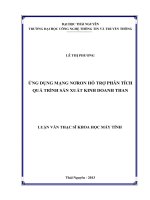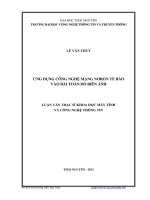mạng nowrron multilayer perceptron
Bạn đang xem bản rút gọn của tài liệu. Xem và tải ngay bản đầy đủ của tài liệu tại đây (493.71 KB, 32 trang )
Multilayer Perceptron
Nguyen Thi Thu Ha
xn
x1
x2
Input
Output
Three-layer networks
Hidden layers
Properties of architecture
•
No connections within a layer
•
No direct connections between input and output layers
•
Fully connected between layers
•
Often more than 3 layers
•
Number of output units need not equal number of input units
•
Number of hidden units per layer can be more or less than
input or output units
Each unit is a perceptron
Often include bias as an extra weight
∑
=
+=
m
j
ijiji
bxwfy
1
)(
In the perceptron/single layer nets, we used gradient descent on the
error function to find the correct weights:
∆ wji = (tj - yj) xi
We see that errors/updates are local to the node ie the change in the
weight from node i to output j (wji) is controlled by the input that
travels along the connection and the error signal from output j
x1
x2
?
x1
(tj - yj)
Backpropagation learning algorithm ‘BP’
Solution to credit assignment problem in MLP. Rumelhart, Hinton and
Williams (1986)
BP has two phases:
Forward pass phase:
computes ‘functional signal’, feedforward
propagation of input pattern signals through network
Backward pass phase:
computes ‘error signal’, propagates the error backwards
through network starting at output units (where the error is the difference
between actual and desired output values)
xn
x1
x2
Inputs xi
Outputs yj
Three-layer networks
y1
ym
2nd layer weights wij
from j to i
1st layer weights vij
from j to i
Outputs of 1st layer zi
We will concentrate on three-layer, but could
easily generalize to more layers
zi (t) = g(
Σ
j vij (t) xj (t) ) at time t
= g ( ui (t) )
yi (t) = g(
Σ
j wij (t) zj (t) ) at time t
= g ( ai (t) )
a/u known as activation, g the activation function
biases set as extra weights
Forward pass
Weights are fixed during forward and backward pass
at time t
1. Compute values for hidden units
2. compute values for output units
xi
vji(t)
wkj(t)
zj
yk
))((
)()()(
tugz
txtvtu
jj
i
ijij
=
=
∑
))((
)()(
tagy
ztwta
kk
j
jkjk
=
=
∑
Backward Pass
Will use a sum of squares error measure. For each training pattern we
have:
where dk is the target value for dimension k.
∑
=
−=
1
2
))()((
2
1
)(
k
kk
tytdtE
How error for pattern changes as function of change
in network input to unit j
How net input to unit j changes as a function of
change in weight w
both for hidden units and output units
Term A
Term B
The partial derivative can be rewritten as product of two terms using
chain rule for partial differentiation
)(
)(
)(
)(
)(
)(
tw
ta
ta
tE
tw
tE
ij
i
iij
∂
∂
∂
∂
∂
∂
•=
Term A Let
(error terms). Can evaluate these by chain rule:
Term B first:
)(
)(
)(,
)(
)(
)(
ta
tE
t
tu
tE
t
i
i
i
i
∂
∂
∂
∂
δ
−=∆−=
)(
)(
)(
)(
)(
)(
tz
tw
ta
tx
tv
tu
j
ij
i
j
ij
i
==
∂
∂
∂
∂
For output units we therefore have:
))()())(((')(
)(
)(
))(('
)(
)(
)(
tytdtagt
ty
tE
tag
ta
tE
t
iiii
i
i
i
i
−−=∆
−=−=∆
∂
∂
∂
∂
For hidden units must use the chain rule:
∑
∑
∆=
=−=
j
jjiii
i
j
j
ji
i
wtugt
tu
ta
ta
tE
tu
tE
t
))((')(
)(
)(
)(
)(
)(
)(
)(
δ
∂
∂
∂
∂
∂
∂
δ
Backward Pass
Weights here can be viewed as providing
degree of ‘credit’ or ‘blame’ to hidden units
∆j
∆k
δi
wki
wji
δi = g’(ai) Σj wji ∆j
Combining A+B gives
So to achieve gradient descent in E should change weights by
vij(t+1)-vij(t) =
η δ
i (t) xj (n)
wij(t+1)-wij(t) =
η ∆
i (t) zj (t)
Where η is the learning rate parameter (0 < η <=1)
)()(
)(
)(
)()(
)(
)(
tzt
tw
tE
txt
tv
tE
ji
ij
ji
ij
∆=−
=−
∂
∂
δ
∂
∂
Summary
Weight updates are local
output unit
hidden unit
)()()()1(
)()()()1(
tzttwtw
txttvtv
jiijij
jiijij
∆=−+
=−+
η
ηδ
∑
∆=
=−+
k
kikji
jiijij
wttxtug
txttvtv
)()())(('
)()()()1(
η
ηδ
)())(('))()((
)()()()1(
tztagtytd
tzttwtw
jiii
jiijij
−=
∆=−+
η
η
Algorithm (sequential)
1. Apply an input vector and calculate all activations, a and u
2. Evaluate ∆k for all output units via:
(Note similarity to perceptron learning algorithm)
3. Backpropagate ∆ks to get error terms δ for hidden layers using:
4. Evaluate changes using:
))(('))()(()( tagtytdt
iiii
−=∆
∑
∆=
k
kikii
wttugt )())((')(
δ
)()()()1(
)()()()1(
tzttwtw
txttvtv
jiijij
jiijij
∆+=+
+=+
η
ηδ
Once weight changes are computed for all units, weights are updated
at the same time (bias included as weights here). An example:
y1
y2
x1
x2
v11= -1
v21= 0
v12= 0
v22= 1
v10= 1
v20= 1
w11= 1
w21= -1
w12= 0
w22= 1
Use identity activation function (ie g(a) = a)
All biases set to 1. Will not draw them for clarity.
Learning rate η = 0.1
y1
y2
x1
x2
v11= -1
v21= 0
v12= 0
v22= 1
w11= 1
w21= -1
w12= 0
w22= 1
Have input [0 1] with target [1 0].
x1= 0
x2= 1
Forward pass. Calculate 1st layer activations:
y1
y2
v11= -1
v21= 0
v12= 0
v22= 1
w11= 1
w21= -1
w12= 0
w22= 1
u2 = 2
u1 = 1
u1 = -1x0 + 0x1 +1 = 1
u2 = 0x0 + 1x1 +1 = 2
x1
x2
Calculate first layer outputs by passing activations thru activation
functions
y1
y2
x1
x2
v11= -1
v21= 0
v12= 0
v22= 1
w11= 1
w21= -1
w12= 0
w22= 1
z2 = 2
z1 = 1
z1 = g(u1) = 1
z2 = g(u2) = 2
Calculate 2nd layer outputs (weighted sum thru activation functions):
y1= 2
y2= 2
x1
x2
v11= -1
v21= 0
v12= 0
v22= 1
w11= 1
w21= -1
w12= 0
w22= 1
y1 = a1 = 1x1 + 0x2 +1 = 2
y2 = a2 = -1x1 + 1x2 +1 = 2
Backward pass:
∆1= -1
∆2= -2
x1
x2
v11= -1
v21= 0
v12= 0
v22= 1
w11= 1
w21= -1
w12= 0
w22= 1
Target =[1, 0] so d1 = 1 and d2 = 0
So:
∆1 = (d1 - y1 )= 1 – 2 = -1
∆2 = (d2 - y2 )= 0 – 2 = -2
)())(('))()((
)()()()1(
tztagtytd
tzttwtw
jiii
jiijij
−=
∆=−+
η
η
Calculate weight changes for 1st layer (cf perceptron learning):
∆1 z1 =-1
x1
x2
v11= -1
v21= 0
v12= 0
v22= 1
w11= 1
w21= -1
w12= 0
w22= 1
z2 = 2
z1 = 1
∆1 z2 =-2
∆2 z1 =-2
∆2 z2 =-4
)()()()1( tzttwtw
jiijij
∆=−+
η
Weight changes will be:
x1
x2
v11= -1
v21= 0
v12= 0
v22= 1
w11= 0.9
w21= -1.2
w12= -0.2
w22= 0.6
)()()()1( tzttwtw
jiijij
∆=−+
η









